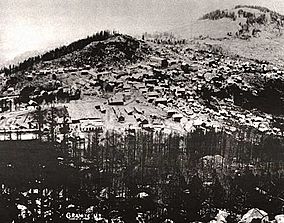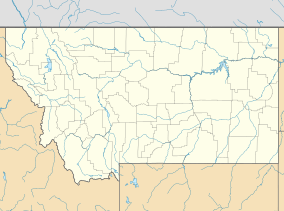Granite, Montana facts for kids
Quick facts for kids Granite Ghost Town State Park |
|
|---|---|

The city of Granite ca. 1895
|
|
| Location | Granite, Montana, United States |
| Nearest town | Philipsburg, Montana |
| Area | 0.6 acres (0.24 ha) |
| Elevation | 7,001 ft (2,134 m) |
| Designation | Montana state park |
| Established | 1875 |
| Visitors | 6,878 (in 2023) |
| Administrator | Montana Fish, Wildlife & Parks |
| Website | Granite Ghost Town State Park |
Granite is a fascinating ghost town located in Granite County, Montana, United States. It's about three miles east of the town of Philipsburg. A ghost town is a place that used to be a busy community but is now mostly empty.
Granite was once a very lively silver mining town in the 1890s. Today, it is completely deserted. The state of Montana helps protect what's left of it. You can visit the old mine superintendent's house and the ruins of the union hall at Granite Ghost Town State Park.
Contents
The Story of Granite
How Granite Began
The story of Granite started in 1872. A man named Eli Holland discovered a small amount of special silver ore called "ruby silver." He dug a shallow hole, but then left it alone.
Later, in 1877, another man named Charles McLure found more silver ore in the same spot. He realized it was a big discovery! Charles then traveled to St. Louis to get money to start a large mining operation.
Life in a Mining Town
Once the mine opened, Granite quickly grew into a busy town. More than 3,000 people lived there. For its time, Granite had many modern things. It had a large building for the Miners Union, a library, and even a hospital and a school. There were also churches and 18 saloons, which were like restaurants and gathering places.
Why Granite Became a Ghost Town
Granite's success depended on silver. But in 1893, a law called the Sherman Silver Purchase Act was ended. This law had helped keep the price of silver high. When it was repealed, the price of silver dropped very quickly.
Because silver was worth less, the mines in Granite could not make enough money. Many people lost their jobs. Most residents had to leave Granite to find work elsewhere. Just one year later, only about 140 people were left. Today, no one lives in Granite. It stands as a silent reminder of its silver mining past.



